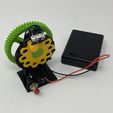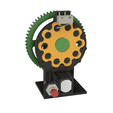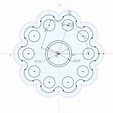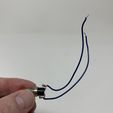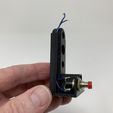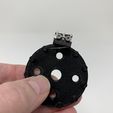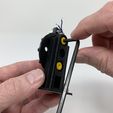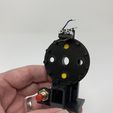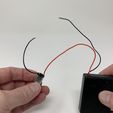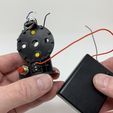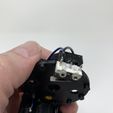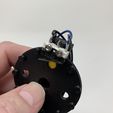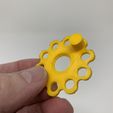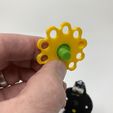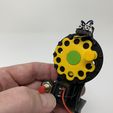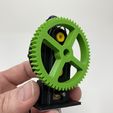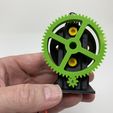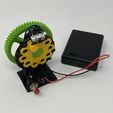Parts.
I acquired the following parts:
• One micro lever switch (search for "CYT1073").
• One normal open mini momentary push button switch.
• One 4 AA battery holder with switch.
• Four AA batteries.
• One N20 6VDC 75RPM gear motor.
• Two M2.5 by 16mm cap screws.
• Two M2.5 nuts.
I 3D printed the following parts at .15mm layer height with 20% infill:
• One "Base.stl".
• Two "Bolt.stl".
• One "Disk.stl".
• One "Gear (1m 56t) and Axle.stl".
• One "Gear, Motor.stl".
• One "Pin, Disk.stl".
• One "Plate.stl".
• One "Retainer.stl".
Prior to assembly, I test fit and trimmed, filed, drilled, sanded, etc. all parts as necessary for smooth movement of moving surfaces, and tight fit for non moving surfaces. Depending on you printer, your printer settings and the colors you chose, more or less trimming, filing, drilling and/or sanding may be required. Carefully file all edges that contacted the build plate to make absolutely certain that all build plate "ooze" is removed and that all edges are smooth. I used small jewelers files and plenty of patience to perform this step.
The mechanism also uses threaded assembly, so I used a tap and die set (6mm by 1) for thread cleaning.
Assembly.
To assemble the mechanism, I performed the following steps:
• Bent the momentary micro switch terminals as shown, then soldered two 100mm lengths of blue wire to the switch terminals.
• Inserted the wires up through the right wiring trough in "Base.stl", then secured the switch to the base using the included nut.
• Attached the micro lever switch to "Plate.stl" using the two 2.5mm cap screws and nuts.
• Attached the plate assembly to the base assembly using two "Bolt.stl".
• Soldered the battery back red wire to the motor "+" terminal.
• Soldered a 100mm length of black wire to the motor "-" terminal.
• Pressed the motor into the base assembly, then routed the motor black wire up the left wiring trough in the base assembly.
• Routed the battery pack black wire up the left wiring trough, then soldered the battery pack black wire and one of the blue momentary micro switch wires to the micro lever switch normally open (NO) terminal.
• Soldered the motor black wire and the remaining blue momentary micro switch wires to the micro lever switch common (C) terminal.
• Pressed "Pin, Disk.stl" into one of the holes in "Disk.stl" and secured in place with a small dot of cyanoacrylate glue.
• Placed "Retainer.stl" in the hole in the disk assembly and positioned the assembly into the tower center hole in the base assembly.
• Secured the disk assembly to the base assembly using "Gear (1m 56t) and Axle.stl" making sure the gear and disk rotated with ease.
• Pressed "Gear, Motor.stl" onto the gear motor shaft.
To operate, I turned on the battery switch and, if not already moving, pressed the momentary switch. Once rotating, with the disk pin comes in contact with the lever on the micro lever switch, the mechanism should stop, if not, adjust the micro lever switch until it does.
And that is how I assembled Cycloidal Disk Electro Mechanical Timer.
I hope you enjoyed it!

/https://fbi.cults3d.com/uploaders/13550170/illustration-file/1c0f6073-970c-483d-ba8e-3b3f311ab889/Image0000a.JPG)
